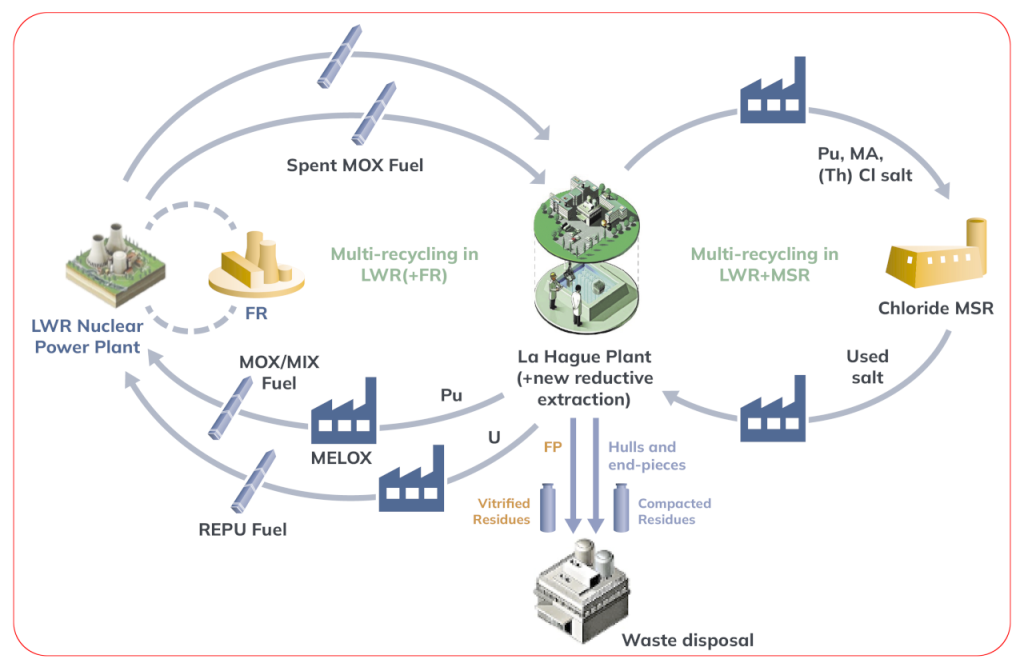
MIMOSA
MIMOSA (MultI-recycling strategies of LWR SNF focusing on MOlten SAlt technology) is a EURATOM Research and Innovation Action that will run from June 2022 to May 2026 with a budget of 5.75M EUR.
It was funded under the call HORIZON-EURATOM-2021-NRT-01 within the topic ‘Multi-recycling of spent nuclear fuel from light water reactors (LWR)’.
The project has been labelled by the Sustainable Nuclear Energy Technology Platform (SNETP).
Context
In a time of heightened environmental concerns and resource scarcity, the closure of the fuel cycle – which reduces the radioactive waste disposal footprint and the need for natural resources – reinforces a sustainable nuclear energy strategy. This involves reprocessing of spent nuclear fuels and the extraction of elements that can be (re)used.
While the EU has the highest share of spent nuclear fuel reprocessing worldwide, most of the spent uranium oxide fuels are declared waste. Multi-recycling in light-water reactors (LWRs) is a tangible solution, but it presents some limitations related to the degradation of the plutonium (Pu) isotopic composition and the generation of minor actinides (MAs).
Cl MSR : a promising technology to achieve closure of the fuel cycle
Significant improvement in converting Pu isotopes and MA into fission products with shorter half-lives can be achieved with the introduction of advanced fast reactor systems, among which the molten salt reactor using Chloride salt (Cl MSRs) is a particularly promising option. In this type of reactor, the fuel is dissolved in the salt circulating through the core, with such liquid form of fuel eliminating the major technological bottleneck of refabrication of solid fuels with high content of transuranics.
Objectives
The MIMOSA project will devise and demonstrate an risk-cost optimised integrated multi-recycling strategy of plutonium and uranium combining multi-recycling options in LWRs with recycling Pu and other transuranics today considered as waste in Cl MSRs using existing European infrastructures such as the Orano reprocessing plant in La Hague (France).
Today, the maturity of Cl MSRs is low. For this reason, MIMOSA will also seek to demonstrate several key aspects of technical feasibility and performance:
Development of synthesis routes of the chloride fuel salt for use at the industrial scale
Selection and qualification of optimised fuel salt composition with respect to thermo-physical properties
Qualification of innovative materials, new corrosion monitoring and mitigation methods, control of accidental situation
Pyro-chemical processes to recycle Pu and MAs
New methods for fission product management: removal, disposal, extraction and purification when valuable
Qualification of codes coupling neutronics and thermo-hydraulics
Impact
MIMOSA will raise the TRL of several Cl MSR-related technologies, processes and materials from 1 or 2 to 3 or 4.
This will pave the way for Cl MSR deployment in Europe, which could be a game changer in nuclear energy through closure of the fuel cycle and a significant reduction in the high-level waste storage footprint.
Furthermore, the project will contribute to the development of materials and technologies that can be useful to other high temperature, high corrosion applications such as the chemical industry or energy storage.
Project news
-
MIMOSA newsletter n°2

The second MIMOSA project newsletter is out!
-
MIMOSA receives the SNETP label

We are glad to announce that the MIMOSA project has been labelled by the Sustainable Nuclear Energy Technology Platform (SNETP). SNETP was established in September 2007 as a R&D&I platform to support and promote the safe, reliable and efficient operation of Generation II, III and IV civil nuclear systems. It is recognised as a European Technology…
-
Workshop on sustainable solutions for radioactive waste management
MIMOSA’s project coordinator, Isabelle Tremillon Morlaes (Orano), participated to a workshop on sustainable solutions for radioactive waste management organised by the Hungarian Presidency of the Council of the European Union. MIMOSA partners THORIZON and the Joint Research Centre were also represented by Kiki Lauwers and Ulla Engelmann, respectively. All three partners highlighted how the research…
-
Interview with Gerald Senentz at the SNETP Forum
Gerald Senentz, Backend Fuel Cycle Expert at Orano, spoke about MIMOSA and his role within the project at the 2024 SNETP Forum, which took place in Rome from 17 to 19 April.
-
MIMOSA Summer School on MSR
From 8 to 12 July, approximately sixty postgraduate students and professionals from across Europe benefitted from a week of lectures by MIMOSA and invited researchers at TU Delft’s Reactor Institute to acquire basic knowledge on the main aspects of the molten salt reactor technology and associated waste management.

Consortium
The MIMOSA consortium, led by nuclear fuel cycle service provider Orano, brings together twelve partners from four European countries with complementary and state-of-the art expertise.













